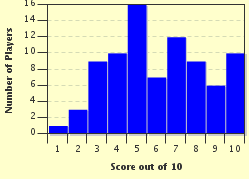Quiz Answer Key and Fun Facts
1. Which of these is the oldest horse racing event?
2. A polo team is made up of how many horse riders?
3. Which of these does NOT feature in competitive equestrian dressage?
4. Coffin, oxer and arrowhead all feature in which type of equestrian sport?
5. Dressage, show jumping and which other event are the three disciplines in horse eventing?
6. In which country did the equestrian steeplechase originate?
7. Which American football team (NFL) has an equine sounding name?
8. Which horse related pastime is the national sport of Argentina?
9. What is the name of the cart used in equestrian harness racing?
10. Which of these British sportsmen was an equestrian gold medalist in the 2012 Summer Paralympics in London?
Source: Author
Plodd
This quiz was reviewed by FunTrivia editor
gtho4 before going online.
Any errors found in FunTrivia content are routinely corrected through our feedback system.


